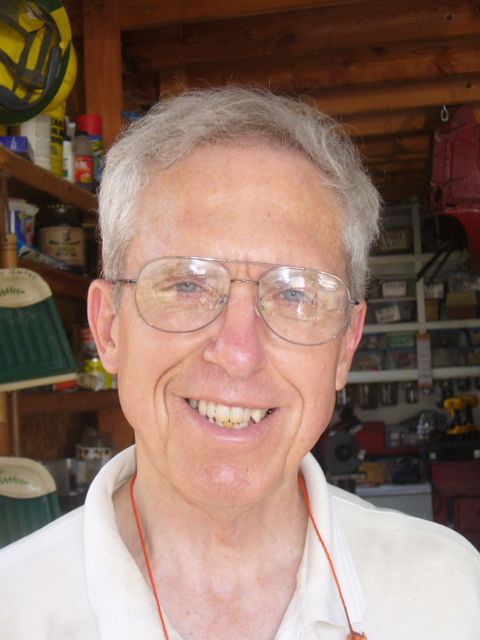
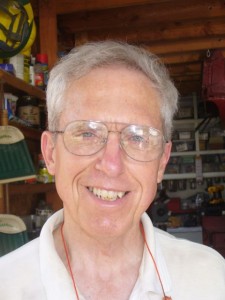 Up until today, I had no idea of the difference between a MGA and a MGB. I didn’t know how to tell apart a ladder frame and a uniframe. I couldn’t even tell a supercharger from a turbocharger. But today, all of that changed, because I met with Dave Whitaker: an enormous car enthusiast (car was his first word) and a firm believer that Formula-1 is entirely better than NASCAR. The day started with Mr. Dave picking me up and taking me to his house for breakfast. At his house, he and his wife Bonnie have a tradition; every Saturday morning, Bonnie fixes pancakes. They have been married over thirty-eight years, and so I figured that Dave has eaten about 2,000 pancake meals. Lucky man. They were some of the best pancakes I’ve ever tasted.
Up until today, I had no idea of the difference between a MGA and a MGB. I didn’t know how to tell apart a ladder frame and a uniframe. I couldn’t even tell a supercharger from a turbocharger. But today, all of that changed, because I met with Dave Whitaker: an enormous car enthusiast (car was his first word) and a firm believer that Formula-1 is entirely better than NASCAR. The day started with Mr. Dave picking me up and taking me to his house for breakfast. At his house, he and his wife Bonnie have a tradition; every Saturday morning, Bonnie fixes pancakes. They have been married over thirty-eight years, and so I figured that Dave has eaten about 2,000 pancake meals. Lucky man. They were some of the best pancakes I’ve ever tasted.
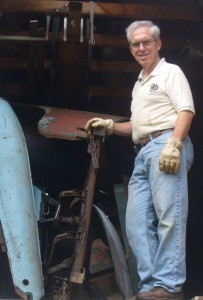 After breakfast, Dave and I headed out to the garage (which he built himself) and started work. We had to get a MGA ladder frame (if you stand it up, it looks like a ladder) suspended on a contraption of Dave’s so he could sandblast, weld, and cut without having to use a jack or anything. Basically, you’ve got a steel wheel welded to a vertical shaft. The wheel has a hole in the middle. Then there is a bar with a bolt attached. The bolt goes through the hole in the wheel, and you attach the bar to your car frame. If you do that on both ends, the result is the frame is suspended in midair, and you can spin it any way you want. Pretty slick, eh? The only catch is that you must figure out a way to attach the frame and bar together. However, ideas aren’t exactly rarities with Dave.
After breakfast, Dave and I headed out to the garage (which he built himself) and started work. We had to get a MGA ladder frame (if you stand it up, it looks like a ladder) suspended on a contraption of Dave’s so he could sandblast, weld, and cut without having to use a jack or anything. Basically, you’ve got a steel wheel welded to a vertical shaft. The wheel has a hole in the middle. Then there is a bar with a bolt attached. The bolt goes through the hole in the wheel, and you attach the bar to your car frame. If you do that on both ends, the result is the frame is suspended in midair, and you can spin it any way you want. Pretty slick, eh? The only catch is that you must figure out a way to attach the frame and bar together. However, ideas aren’t exactly rarities with Dave.
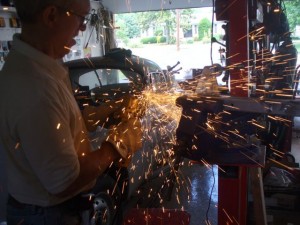 Almost immediately, Dave built in his mind a design that would work. Step two: making it happen. He began by taking an old bed frame (he uses them like crazy) and cutting off two pieces. He took this opportunity to teach me how to properly use a hacksaw. Some people think that to cut something, you just saw back and forth like mad. However, that is not the case. See, when cutting metal, you put all your energy into the push-stroke, and then lift up on the blade on the pull-stroke. That keeps the saw from heating up, becoming soft, and ultimately totally dulling the tooth edges. After the bed frame was cut, Dave then smoothed the edge with an electric sander to keep anyone from accidentally being hurt.
Almost immediately, Dave built in his mind a design that would work. Step two: making it happen. He began by taking an old bed frame (he uses them like crazy) and cutting off two pieces. He took this opportunity to teach me how to properly use a hacksaw. Some people think that to cut something, you just saw back and forth like mad. However, that is not the case. See, when cutting metal, you put all your energy into the push-stroke, and then lift up on the blade on the pull-stroke. That keeps the saw from heating up, becoming soft, and ultimately totally dulling the tooth edges. After the bed frame was cut, Dave then smoothed the edge with an electric sander to keep anyone from accidentally being hurt.
As soon as Mr. Dave had completed the sanding, he made a few measurements on the MG frame, and took the bed frame segments to another machine; the drill. It was a huge piece of equipment, able to drill holes in just about anything. Instead of simply holding the part you wish to drill down on the platform, it has a clamp to hold the piece, and also x and y axis to maneuver the clamp around. Talk about sophisticated.
One of the things Dave took the opportunity to teach me about was the history of MG’s. Back in the 1920’s, there was a company by the name of Morris. They (obviously) made cars, and made them pretty well. Something else you should know; back in those days, the favorite pastime was hill racing. You go to an old farm road, put a marker at the bottom and one at the top, and see who goes the fastest. Hill racing was basically the father of Formula-1, because you’re actually going somewhere; it isn’t just “go fast, turn left” like NASCAR. Now, back to the story.
One of the men in the Morris organization, pretty high up, had so much influence that he could take parts from Morris, build a car in his spare time, and only have to pay the company the price of the parts. So one day, he took some parts, and made a new car. The man thought the car looked good, and decided to hill race it. He did, and it blew the competition out of the water. One of the other racers came over and said, “How much for the car? I want to buy it!” So the man made another one, with a few improvements. Pretty soon, tons of people wanted one. Well, it was about this time that the company woke up and thought, “you know, we could be making money off of this!” So they started a new division making this car, and they it called Morris Garages. Thus, the MG was birthed. As the company grew, MG decided to make a line of cars starting with A, and going to Z. That’s why there are MGB’s, MGC’s, etc.
When the story was finished, we got back to work. Now, the once-bed frame now had three holes right down its middle, and it was five inches long. Dave also beat down one of the ends of the frame with a hammer to form a half-box. Step three, welding. Dave is a certified welder on horizontal planes, vertical planes, and inverted (above your head) planes. The last one is the hardest, because you are having to keep gravity from working and making molten metal drip on your face. The number one rule is to wear the safety mask. The flame at the end of a welding torch is somewhere around 5,000 degrees, and staring at it would be like looking dead on into the sun. Also, pro welders call the end of the torch the “stinger”. Because the machine takes 240 volts and turns it into 30,000, you don’t want to get stung.
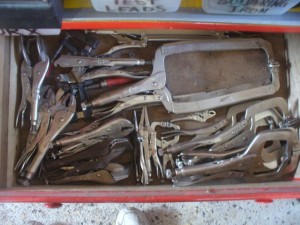
You wouldn’t think so, but one of the most important tools of a welder is a pair of vice-grip pliers. They are very handy to make the object you are welding steady, and to keep it from jerking around. Dave understands this fully; in fact, he probably has one of the largest collections of vice-grips in America. and in case you didn’t think that there were over 25 different kinds of vice-grips, I took a picture to prove it.
After Dave had welded the folded down piece of bed frame in place (one of the holes he drilled was in that piece), he pushed a bolt through the hole and welded it in place. I’m sorry that I didn’t get any pictures of Dave welding, but the brightness would probably ruin the camera, and I don’t think dad would like that.
After he had the bolts on, Dave welded the transformed bed frames onto the metal bar. The end was in sight. We bolted the bar to the rear of the ladder 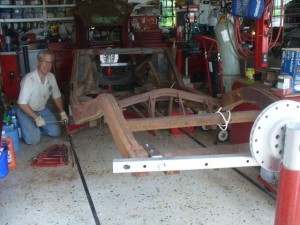 frame, and then did the same for the front. We lifted up the frame onto the two metal wheels, bolted them in place, and success! we were finished. Dave now had a frame that he could spin any direction with one finger, and he could move it anywhere he wanted by himself (it has wheels). To celebrate this momentous occasion, we went inside and ate lunch, which for me consisted of BLT’s, lemonade, and Sunchips. Life can’t get more perfect than that, I don’t think.
frame, and then did the same for the front. We lifted up the frame onto the two metal wheels, bolted them in place, and success! we were finished. Dave now had a frame that he could spin any direction with one finger, and he could move it anywhere he wanted by himself (it has wheels). To celebrate this momentous occasion, we went inside and ate lunch, which for me consisted of BLT’s, lemonade, and Sunchips. Life can’t get more perfect than that, I don’t think.
I’ve left a lot of stuff out, like the fact that Dave has micrometer eyes, or that Morris Garages once made a car whose engine would almost always explode, but I hope that the things I did put in make you appreciate the beauty of working with cars, and I hope you come away wanting to learn more about the subject. And by the way, I think that Formula-1 is better than NASCAR, too.